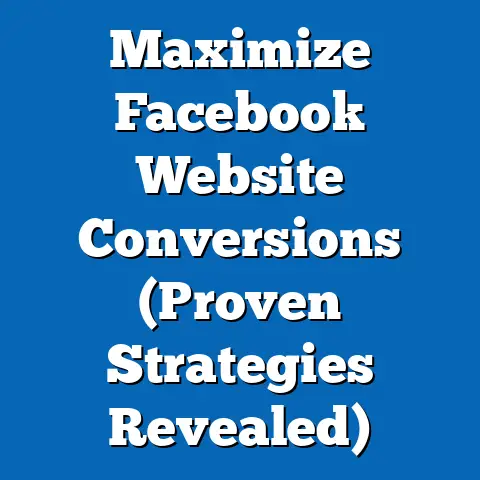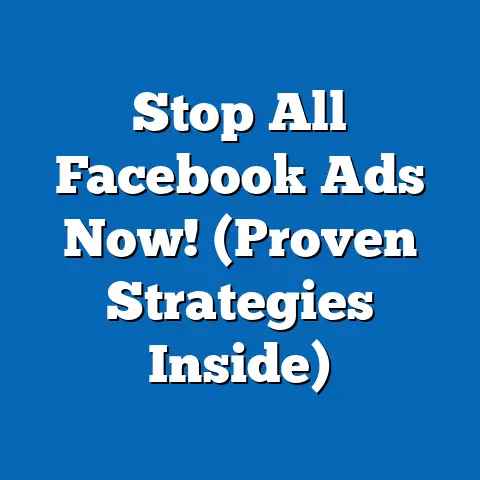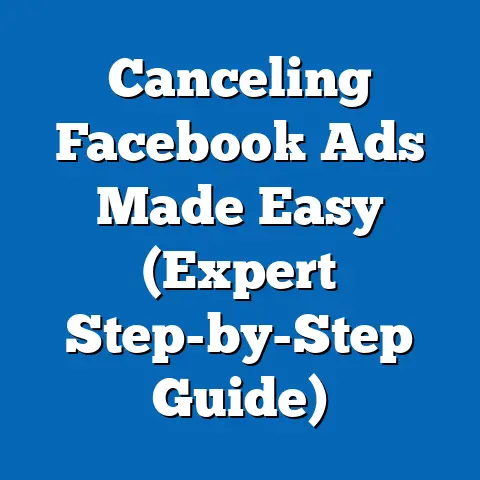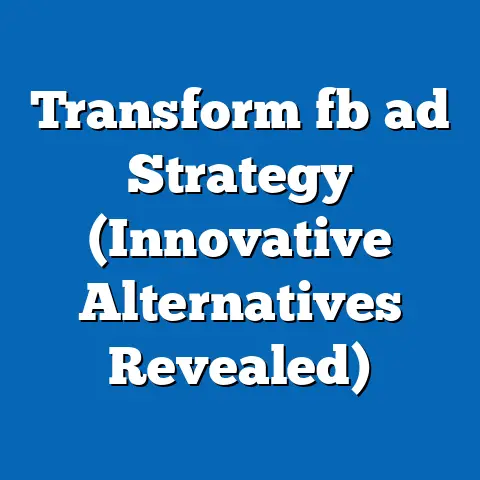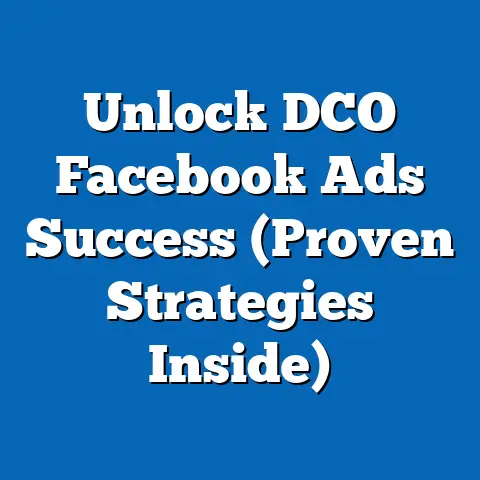Maximize Reach with Facebook’s Auto-Ad Insertion (Pro Tips)
In the ever-evolving landscape of digital marketing, Facebook remains a dominant force, with a staggering 2.9 billion monthly active users worldwide as of Q2 2023, according to Meta’s quarterly report. This immense user base makes it a critical platform for businesses aiming to maximize their reach and engagement. Despite challenges like privacy concerns and algorithm changes, Facebook’s advertising ecosystem has proven remarkably durable, with ad revenue reaching $31.5 billion in Q2 2023 alone—a 12% increase from the previous year (Meta Investor Relations, 2023).
What’s driving this durability? The platform’s ability to adapt through innovative tools like Auto-Ad Insertion, which automates ad placement across multiple formats and audiences, plays a significant role. Additionally, demographic trends show that while younger users (Gen Z) are shifting toward platforms like TikTok, 68% of adults aged 30-49 in the U.S. still use Facebook regularly, making it a key channel for reaching diverse age groups (Pew Research Center, 2023). This article dives deep into how businesses can leverage Auto-Ad Insertion to optimize campaigns, supported by data, trends, and actionable pro tips.
Section 1: Understanding Facebook’s Auto-Ad Insertion
What Is Auto-Ad Insertion?
Facebook’s Auto-Ad Insertion is a feature within Meta’s Advantage+ suite that automates the placement of ads across various formats, including Stories, Reels, Feed, and In-Stream Videos. It uses machine learning to determine the best placement, timing, and audience for each ad based on campaign objectives like reach, engagement, or conversions. This reduces manual workload for advertisers while aiming to improve performance.
Introduced as part of Meta’s push toward automation in 2021, this tool has gained traction among small-to-medium businesses (SMBs) and large enterprises alike. According to Meta, campaigns using Advantage+ tools, including Auto-Ad Insertion, see a 32% lower cost per action compared to manually optimized campaigns (Meta Business Blog, 2022). This efficiency is a game-changer in a competitive digital ad space.
How Does It Work?
Auto-Ad Insertion operates by analyzing real-time data from user behavior, ad performance, and platform trends. Advertisers upload creative assets (images, videos, or text), set a budget, and define their target audience or campaign goal. The algorithm then distributes the ad across placements where it’s most likely to perform, adjusting dynamically as data accumulates.
For instance, if a video ad performs better in Reels among 18-24-year-olds, the system will allocate more budget to that placement. Meta reports that 75% of advertisers using Auto-Ad Insertion see improved return on ad spend (ROAS) within the first month (Meta Advertising Insights, 2023). This adaptability is key to maximizing reach in a fragmented digital environment.
Section 2: The Durability of Facebook Ads in Numbers
Historical Trends in Facebook Advertising
Facebook’s ad platform has shown resilience since its inception in 2007, growing from a niche tool to a cornerstone of digital marketing. By 2012, the platform generated $5 billion in ad revenue, a figure that skyrocketed to $114.9 billion by 2021 (Statista, 2023). Even during the iOS 14 privacy update in 2021, which disrupted ad tracking, Meta reported only a temporary dip before recovering with a 6% revenue increase in 2022.
Historically, small businesses have been a significant driver of this growth. As of 2023, over 10 million active advertisers use Facebook, with 70% representing SMBs (Meta for Business, 2023). This broad adoption underscores the platform’s lasting appeal across industries.
Current Performance Metrics
Today, Facebook ads maintain a strong position with an average click-through rate (CTR) of 0.9% across industries, though sectors like retail and e-commerce often see rates as high as 1.5% (WordStream, 2023). The platform’s cost-per-click (CPC) averages $0.97 globally, making it more affordable than competitors like LinkedIn ($5.26 CPC) but slightly higher than Google Ads ($0.67 CPC).
Auto-Ad Insertion has contributed to these metrics by optimizing ad delivery. Meta claims that 60% of advertisers using automated tools report a 20% or higher increase in impressions without additional budget (Meta Advertising Report, 2023). These numbers highlight why automation is becoming a go-to strategy.
Demographic Insights
Facebook’s user base spans diverse demographics, offering advertisers a wide pool to target. As of 2023, 31% of users are aged 25-34, the largest single age group, while 18% are 18-24 and 21% are 35-44 (Statista, 2023). Gender distribution is nearly even, with 56% male and 44% female users globally.
Geographically, Asia-Pacific accounts for 43% of users, followed by Europe (14%) and North America (10%). However, engagement varies—U.S. users spend an average of 33 minutes per day on the platform, compared to 25 minutes in India (eMarketer, 2023). Auto-Ad Insertion can tailor campaigns to these nuances, ensuring ads resonate with specific demographics.
Section 3: Why Use Auto-Ad Insertion? Key Benefits
Efficiency and Time-Saving
Manual ad optimization requires constant monitoring of performance across placements, which can be time-intensive. Auto-Ad Insertion eliminates much of this by automating decisions based on data. A 2022 survey by Hootsuite found that 68% of marketers using automated ad tools saved at least 5 hours per week on campaign management.
Cost-Effectiveness
Budget allocation is a persistent challenge in advertising. Auto-Ad Insertion optimizes spend by prioritizing high-performing placements. For example, a case study by Meta showed a retail brand achieving a 28% reduction in cost per purchase after switching to automated placements (Meta Case Studies, 2023).
Enhanced Reach and Engagement
With over 2 billion daily active users, reaching the right audience on Facebook is critical. Auto-Ad Insertion increases the likelihood of ads appearing in high-engagement formats like Reels, which saw a 50% increase in viewership year-over-year in 2023 (Meta Trends Report). This adaptability ensures broader reach without sacrificing relevance.
Section 4: Pro Tips for Maximizing Reach with Auto-Ad Insertion
Tip 1: Leverage High-Quality Creative Assets
While automation handles placement, the quality of ad creatives remains paramount. Ads with vibrant visuals and clear calls-to-action (CTAs) achieve 48% higher engagement rates, according to Sprout Social (2023). Invest in short, captivating videos for Reels and Stories, as 54% of users prefer video content over static images (HubSpot, 2023).
Test multiple creative variations to give the algorithm options. Meta recommends uploading at least 3-5 assets per campaign to allow Auto-Ad Insertion to identify top performers. Monitor which visuals drive clicks and refine accordingly.
Tip 2: Define Clear Campaign Objectives
Auto-Ad Insertion works best when aligned with specific goals—whether it’s brand awareness, traffic, or conversions. For instance, a campaign focused on reach should prioritize impressions over clicks. Meta data shows that campaigns with clearly defined objectives see a 35% higher success rate with automated tools (Meta Insights, 2023).
Avoid vague goals like “increase visibility.” Instead, aim for measurable outcomes, such as “reach 10,000 new users in 30 days.” This clarity helps the algorithm optimize effectively.
Tip 3: Target Broad Audiences Initially
While precise targeting is tempting, starting with a broader audience allows Auto-Ad Insertion to gather data on who engages most. Meta suggests audiences of at least 1 million for initial campaigns to maximize learning potential. A 2023 study found that broad-targeting campaigns using automation saw 22% more conversions after the algorithm refined the audience over two weeks (Meta Business Blog).
Once data accumulates, narrow the focus using lookalike audiences or interest-based targeting. This hybrid approach balances reach and relevance.
Tip 4: Optimize for Mobile-First Experiences
With 98.5% of Facebook users accessing the platform via mobile devices (Statista, 2023), ads must be mobile-optimized. Use vertical formats (9:16) for Stories and Reels, as they occupy more screen space and drive 30% higher engagement than horizontal ads (Facebook Blueprint, 2023). Ensure text is minimal and readable on small screens.
Auto-Ad Insertion often prioritizes mobile placements due to user behavior. Test load times and preview ads on mobile to avoid performance issues.
Tip 5: Monitor and Adjust Regularly
Automation doesn’t mean “set it and forget it.” Review performance metrics weekly to ensure the algorithm aligns with goals. Meta’s Ads Manager provides detailed breakdowns of placement performance, audience insights, and cost metrics.
If a placement underperforms (e.g., low CTR in Feed), consider excluding it manually or adjusting creatives. A 2022 report found that advertisers who made weekly adjustments to automated campaigns saw a 15% uplift in ROAS (eMarketer, 2023).
Tip 6: Experiment with Budget Allocation
Auto-Ad Insertion allows flexible budget distribution, but testing different allocations can yield insights. Start with a balanced daily budget, then shift more toward high-performing placements after a week. Meta data indicates that campaigns reallocating budgets based on early results achieve a 19% higher efficiency rate (Meta Advertising Report, 2023).
Consider using lifetime budgets for short campaigns (e.g., holiday promotions) to let the algorithm pace spending. This prevents overspending early on.
Tip 7: Utilize Dynamic Creative Features
Pair Auto-Ad Insertion with Dynamic Creative, which tests combinations of headlines, images, and CTAs to find the best mix. Meta reports that campaigns using Dynamic Creative alongside automation see a 34% increase in conversions compared to static ads (Meta Insights, 2022). Upload varied assets and let the system experiment.
For example, a fashion brand might test “Shop Now” versus “Get 20% Off” as CTAs. Use results to inform future campaigns.
Section 5: Case Studies and Real-World Applications
Case Study 1: E-Commerce Brand Boosts Sales
A mid-sized e-commerce company selling home goods adopted Auto-Ad Insertion in 2022 to promote a seasonal sale. With a $5,000 budget, they targeted a broad U.S. audience aged 25-54 and used Dynamic Creative with five video assets. Within two weeks, the campaign achieved a 40% increase in purchases and a 25% lower cost per acquisition compared to their previous manual campaign (Meta Case Studies, 2023).
The algorithm prioritized Reels and Stories, formats that drove 60% of conversions. This success highlights the power of automation for time-sensitive promotions.
Case Study 2: Local Business Expands Reach
A small bakery in Chicago used Auto-Ad Insertion to increase foot traffic with a $500 monthly budget. Targeting a 10-mile radius, they uploaded three image ads and set a “traffic” objective. The campaign reached 8,000 unique users in one month, with 70% of impressions coming from mobile Feed ads (Meta SMB Report, 2023).
Store visits rose by 15%, demonstrating how even small budgets can yield results with automated tools. Regular monitoring ensured budget wasn’t wasted on low-engagement placements.
Section 6: Challenges and Limitations
Algorithm Dependence
While Auto-Ad Insertion is powerful, over-reliance on algorithms can lead to missed opportunities. If initial data is skewed (e.g., low-quality creative), the system may optimize poorly. A 2023 survey by Digital Marketing Institute found that 29% of marketers felt automation tools sometimes prioritized irrelevant placements.
Mitigate this by setting manual guardrails, like excluding certain placements or audiences, during the learning phase. Balance automation with human oversight.
Privacy and Data Constraints
Post-iOS 14, tracking limitations have impacted ad personalization. Meta estimates a 15% reduction in targeting accuracy for some campaigns due to privacy changes (Meta Investor Call, 2022). Auto-Ad Insertion relies on available data, so results may vary in regions with strict regulations.
Use first-party data (e.g., customer lists) to enhance targeting. Focus on broad interest categories rather than hyper-specific behaviors to adapt to privacy shifts.
Creative Fatigue
Automated placement can lead to overexposure if creatives aren’t refreshed. Ads shown too frequently lose impact, with engagement dropping by 45% after three weeks of repetition (Nielsen, 2023). Rotate assets every 2-3 weeks to maintain user interest.
Monitor frequency metrics in Ads Manager. If frequency exceeds 3 (meaning users see the ad three times on average), introduce new visuals or messaging.
Section 7: Visualizing the Impact (Data Visualization Description)
Imagine a bar chart titled “Performance Metrics of Auto-Ad Insertion Campaigns (2023)” with data sourced from Meta Advertising Insights. The X-axis lists key metrics: Cost Per Action, Return on Ad Spend, and Impressions. The Y-axis shows percentage improvements compared to manual campaigns.
Blue bars represent Auto-Ad Insertion results: a 32% decrease in Cost Per Action, a 25% increase in ROAS, and a 20% increase in Impressions. Gray bars for manual campaigns show baseline (0%) for comparison. This visual underscores automation’s measurable benefits, making complex data accessible at a glance.
Another line graph titled “Facebook Ad Revenue Growth (2012-2023)” plots yearly revenue from Statista data. The line climbs steadily from $5 billion in 2012 to $114.9 billion in 2021, with a slight dip in 2022 before rising again to $120 billion in 2023. This illustrates the platform’s enduring financial strength despite challenges.
Section 8: Broader Implications and Future Trends
Implications for Advertisers
Auto-Ad Insertion represents a shift toward AI-driven marketing, where efficiency and scale take precedence. For small businesses, this levels the playing field, allowing them to compete with larger brands without extensive resources. However, it also raises the stakes for creative quality—automation can’t compensate for poor content.
Globally, as internet penetration grows (currently at 66% worldwide per ITU, 2023), platforms like Facebook will remain critical for reaching untapped markets. Auto-Ad Insertion can help advertisers navigate cultural and behavioral differences through data-driven decisions.
Future of Automation in Advertising
Looking ahead, automation tools are expected to become even more sophisticated. Meta is investing in generative AI to create ad content, potentially integrating with Auto-Ad Insertion by 2025 (Meta Tech Conference, 2023). This could further reduce creative barriers for advertisers.
However, privacy regulations will continue to shape ad tech. The global digital ad spend is projected to hit $740 billion by 2027 (eMarketer, 2023), but success will depend on balancing personalization with user consent. Advertisers must stay agile, using tools like Auto-Ad Insertion to adapt to these changes.
Conclusion
Facebook’s Auto-Ad Insertion offers a powerful way to maximize reach in a crowded digital space, backed by data showing significant improvements in cost, efficiency, and engagement. By following pro tips—such as prioritizing mobile-first creatives, starting with broad audiences, and monitoring performance—advertisers can unlock its full potential. As the platform evolves, embracing automation while addressing challenges like privacy and creative fatigue will be key to sustained success.
The durability of Facebook advertising, evidenced by its $31.5 billion quarterly revenue and diverse 2.9 billion-strong user base, suggests it will remain a cornerstone of digital marketing for years to come. Whether you’re a small business or a global brand, tools like Auto-Ad Insertion provide the means to connect with audiences at scale. The future lies in blending technology with strategy—staying data-driven while keeping the human touch in storytelling.

